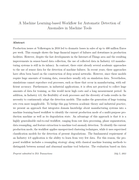New publication in ISA Transactions [12.07.21]
Christian Krupitzer from the Department of Food Informatics is co-author of the publication "A Machine Learning-based Workflow for Automatic Detection of Anomalies in Machine Tools" in ISA Transactions (Impact Factor: 5.468).The publication "A Machine Learning-based Workflow for Automatic Detection of Anomalies in Machine Tools" by Marwin Züfle (University of Würzburg) with co-authors Felix Moog (Bosch Rexroth AG), Veronika Lesch (University of Würzburg), Christian Krupitzer (Department of Food Informatics, University of Hohenheim) and Samuel Kounev (University of Würzburg) was published in Elsevier ISA Transactions (Impact Factor: 5.468).
Despite the increased sensor-based data collection in Industry 4.0, the practical use of this data is still in its infancy. In contrast, academic literature provides several approaches to detect machine failures but, in most cases, relies on simulations and vast amounts of training data. Since it is often not practical to collect such amounts of data in an industrial context, we propose an approach to detect the current production mode and machine degradation states on a comparably small data set. Our approach integrates domain knowledge about manufacturing systems into a highly generalizable end-to-end workflow ranging from raw data processing, phase segmentation, data resampling, and feature extraction to machine tool anomaly detection. The workflow applies unsupervised clustering techniques to identify the current production mode and supervised classification models for detecting the present degradation. A resampling strategy and classical machine learning models enable the workflow to handle small data sets and distinguish between normal and abnormal machine tool behavior. To the best of our knowledge, there exists no such end-to-end workflow in the literature that uses the entire machine signal as input to identify anomalies for individual tools. Our evaluation with data from a real multi-purpose machine shows that the proposed workflow detects anomalies with an average F1-score of almost 93%.
The publication is available on ScienceDirect.


